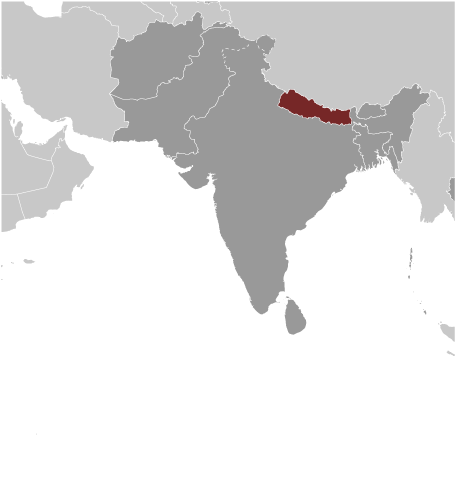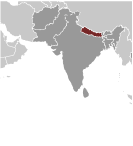
|
|
Advertisements:
GovernmentCountry name
Conventional long form
Federal Democratic Republic of Nepal Conventional short form NepalLocal long form Sanghiya Loktantrik Ganatantra Nepal Local short form NepalGovernment type
Federal democratic republic
Capital
Name Kathmandu
Geographic coordinates 27 43 N, 85 19 E Time difference UTC+5.75 (10.75 hours ahead of Washington, DC during Standard Time) Administrative divisions
14 zones (anchal, singular and plural); Bagmati, Bheri, Dhawalagiri, Gandaki, Janakpur, Karnali, Kosi, Lumbini, Mahakali, Mechi, Narayani, Rapti, Sagarmatha, Seti Independence
1768 (unified by Prithvi Narayan SHAH) National holiday
Republic Day, 29 May
Constitution
15 January 2007 (interim Constitution); note - in April 2008, a Constituent Assembly was elected as an interim parliament to draft and promulgate a new constitution by May 2010; the deadline has been extended four times, most recently until May 2012 Legal system
English common law and Hindu legal concepts International law organization participation
Has not submitted an ICJ jurisdiction declaration; non-party state to the ICCt Suffrage
18 years of age; universal
Executive branch
Chief of state
President Ram Baran YADAV (since 23 July 2008); Vice President Paramananda JHA (since 23 July 2008) Head of government Prime Minister Baburam BHATTARAI (since 29 August 2011); Deputy Prime Ministers Bijay Kumar GACHCHADAR (since 29 August 2011) and Narayan Kaji SHRESTHA Cabinet Cabinet was formed in August-September 2011 by a majority coalition made up of the United Communist Party of Nepal-Maoist, Madhesi People's Rights Forum-Democratic, Madhesi People's Rights Forum-Republic, Madhesi People's Rights Forum-Nepal, Terai-Madhes Democratic Party, and several smaller parties Elections President elected by Parliament; term extends until the new constitution is promulgated; election last held on 21 July 2008; date of next election NA Election results Ram Baran YADAV elected president by the Constituent Assembly in a second round of voting on 21 July 2008; Ram Baran YADAV 308, Ram Jaja Prasad SINGH 282 Legislative branch
Unicameral Constituent Assembly (601 seats; 240 members elected by direct popular vote, 335 by proportional representation, and 26 appointed by the Cabinet (Council of Ministers)) Elections Last held on 10 April 2008; note - the Constituent Assembly failed to draft a new constitution by the 27 May 2012 deadline, forcing a November election of a new Assembly Election results Percent of vote by party - CPN-M 38%, NC 19%, CPN-UML 18%, Madhesi People's Right Forum 9%, other 11%; seats by party - CPN-M 229, NC 115, CPN-UML 108, Madhesi People's Rights Forum 54, Terai Madhes Democratic Party 21, other smaller parties 74; note - 26 seats filled by the new Cabinet are included in the totals above Judicial branch
Supreme Court or Sarbochha Adalat (the president appoints the chief justice on recommendation of the Constitutional Council; the chief justice appoints other judges on the recommendation of the Judicial Council) Political parties and leaders
Chure Bhawar Rastriya Ekata Party [Badri Prasad NEUPANE]; Communist Party of Nepal-Marxist Leninist or CPN-ML [C.P. MAINALI]; Communist Party of Nepal-Marxist Leninist Samaibadi [Jaqat Bahadur BOGATI]; Communist Party of Nepal-Unified [Raj Singh SHRIS]; Communist Party of Nepal-United [Chandra Dev JOSHI]; Communist Party of Nepal-Unified Marxist-Leninist or CPN-UML [Jhalanath KHANAL]; Dalit Janajati Party [Vishwendraman PASHWAN]; Federal Democratic National Forum; Federal Democratic National Party [Yogendra CHAUDBARI]; Federal Sadbhayana Party [Anil JHAL]; Madhesi People's Rights Forum-Democratic [Bijay Kumar GACHHADAR]; Madhesi People's Rights Forum-Nepal [Upendra YADAV]; Madhesi People's Rights Forum-Republic [Jaya Prakash GUPTA]; Nepal Loktantrik Samajbadi Dal [Laxmi Lal CHAUDBARY]; Nepal Pariwar Dal [Eknath DHAKAL]; Nepal Workers and Peasants Party [Narayan Man BIJUKCHHE]; Nepali Congress or NC [Sushil KOIRALA]; Nepali Janata Dal [Harish Chandra SHA]; Newa Rastriya Party [Keshav Man SHAKYA]; Rastriya Janamorcha [Chitra Bahadur K.C.]; Rastriya Janamukti Party [Malwar Singh THAPA]; Rastriya Janashakti Party or RJP [Surya Bahadur THAPA]; Rastriya Prajantantra Party [Pashupati Shumsher RANA]; Rastriya Prajantantra Party Nepal [Kamal THAPA]; Sadbhavana Party [Rajendra MAHATO]; Sadbhavana Party-Anandi Devi [Sarita GIRI]; Samajbadi Prajatantrik Janata Party Nepal [Prem Bahadur SINGH]; Terai Madhes Democratic Party [Mahantha THAKUR]; Terai Madhes Democratic Party-Nepal [Mahendra YADAVI]; Unified Communist Party of Nepal (Maoist) [Pushpa Kamal DAHAL, also known as PRACHANDA] Political pressure groups and leaders
Other
Several small armed Madhesi groups along the southern border with India; a variety of groups advocating regional autonomy for individual ethnic groups International organization participation
ADB, BIMSTEC, CP, FAO, G-77, IAEA, IBRD, ICAO, ICC, ICRM, IDA, IFAD, IFC, IFRCS, ILO, IMF, IMO, Interpol, IOC, IOM, IPU, ISO (correspondent), ITSO, ITU, ITUC, MIGA, MINURSO, MINUSTAH, MONUSCO, NAM, OPCW, SAARC, SACEP, UN, UNAMID, UNCTAD, UNESCO, UNIDO, UNIFIL, UNMIL, UNMISS, UNMIT, UNOCI, UNTSO, UNWTO, UPU, WCO, WFTU, WHO, WIPO, WMO, WTO Diplomatic representation in the us
Chief of mission
Ambassador Shankar Prasad SHARMA Chancery 2131 Leroy Place NW, Washington, DC 20008 Telephone [1] (202) 667-4550FAX [1] (202) 667-5534 Consulate(s) general New York Diplomatic representation from the us
Chief of mission
Ambassador (vacant); Charge d'Affaires Patricia MAHONEY Embassy Maharajgunj, KathmanduMailing address Use embassy street address Telephone [977] (1) 400-7200 FAX [977] (1) 400-7272 Flag description
Red with a blue border around the unique shape of two overlapping right triangles; the smaller, upper triangle bears a white stylized moon and the larger, lower triangle displays a white 12-pointed sun; the color red represents the rhododendron (Nepal's national flower) and is a sign of victory and bravery, the blue border signifies peace and harmony; the two right triangles are a combination of two single pennons (pennants) that originally symbolized the Himalaya Mountains while their charges represented the families of the king (upper) and the prime minister, but today they are understood to denote Hinduism and Buddhism, the country's two main religions; the moon represents the serenity of the Nepalese people and the shade and cool weather in the Himalayas, while the sun depicts the heat and higher temperatures of the lower parts of Nepal; the moon and the sun are also said to express the hope that the nation will endure as long as these heavenly bodies Note Nepal is the only country in the world whose flag is not rectangular or square National symbol(s)
Rhododendron blossom
National anthem
Name
"Sayaun Thunga Phool Ka" (Hundreds of Flowers) Lyrics/music Pradeep Kumar RAI/Ambar GURUNGNote Adopted 2007; after the abolition of the monarchy in 2006, a new anthem was required because of the previous anthem's praise for the king
Comments
Add a new comment: |
Advertisement
Members area
Nepal (Kathmandu):
 
GPS points from Nepal (Kathmandu)
|
||||||||

 In 1951, the Nepali monarch ended the century-old system of rule by hereditary premiers and instituted a cabinet system of government. Reforms in 1990 established a multiparty democracy within the framework of a constitutional monarchy. An insurgency led by Maoist extremists broke out in 1996. The ensuing 10-year civil war between insurgents and government forces witnessed the dissolution of the cabinet and parliament and assumption of absolute power by the king. Several weeks of mass protests in April 2006 were followed by several months of peace negotiations between the Maoists and government officials, and culminated in a November 2006 peace accord and the promulgation of an interim constitution. Following a nation-wide election in April 2008, the newly formed Constituent Assembly declared Nepal a federal democratic republic and abolished the monarchy at its first meeting the following month. The Constituent Assembly elected the country's first president in July. Between 2008 and 2011 there have been four different coalition governments, led twice by the United Communist Party of Nepal-Maoist, which received a plurality of votes in the Constituent Assembly election, and twice by the Communist Party of Nepal-United Marxist-Leninist. In November 2011, Maoist Prime Minister Baburam BHATTARAI, who was elected in August 2011, and the leaders of the main political parties signed an agreement seeking to conclude the peace process and recommit the Constituent Assembly to finish drafting the constitution by a May 2012 deadline.
In 1951, the Nepali monarch ended the century-old system of rule by hereditary premiers and instituted a cabinet system of government. Reforms in 1990 established a multiparty democracy within the framework of a constitutional monarchy. An insurgency led by Maoist extremists broke out in 1996. The ensuing 10-year civil war between insurgents and government forces witnessed the dissolution of the cabinet and parliament and assumption of absolute power by the king. Several weeks of mass protests in April 2006 were followed by several months of peace negotiations between the Maoists and government officials, and culminated in a November 2006 peace accord and the promulgation of an interim constitution. Following a nation-wide election in April 2008, the newly formed Constituent Assembly declared Nepal a federal democratic republic and abolished the monarchy at its first meeting the following month. The Constituent Assembly elected the country's first president in July. Between 2008 and 2011 there have been four different coalition governments, led twice by the United Communist Party of Nepal-Maoist, which received a plurality of votes in the Constituent Assembly election, and twice by the Communist Party of Nepal-United Marxist-Leninist. In November 2011, Maoist Prime Minister Baburam BHATTARAI, who was elected in August 2011, and the leaders of the main political parties signed an agreement seeking to conclude the peace process and recommit the Constituent Assembly to finish drafting the constitution by a May 2012 deadline.